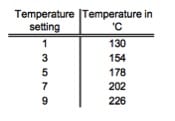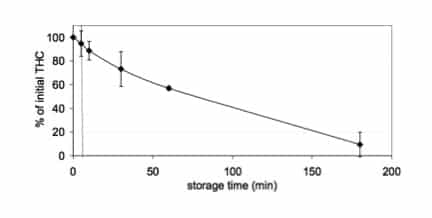Have you ever wondered if you were getting the most out of your vaporizer? Perhaps you’re curious about how long vapor can be stored without losing potency? Unfortunately these simple questions can be difficult to answer because vaporizer companies often don’t provide technical research on the subject; careful medical testing of cannabis vaporization devices is uncommon. Yet, as vaporizers grow in popularity and cannabis becomes more culturally mainstream, information is becoming increasingly available. One prominent figure in the medical cannabis research movement, Arno Hazekamp, from the University of Leiden in Holland, focuses on answering very practical questions with sophisticated, quantitative methods. His text, Extracting the Medicine, will be the basis of reviewing functionality of vaporizers in this article.
Perhaps the most widespread, non-portable vaporizer design is the balloon-based model. This design catches vapor produced in a temperature-safe bag, referred to as a “balloon”. The balloon adds a significant functionality to any vaporization system. Most apparent, of course, is the ability to de-tether oneself from the source of heat or vaporization. However, the true benefit of the balloon is the ability to breathe at any rate or in any fashion comfortable for the patient. In addition, the vapor in a balloon is typically cooler in temperature than that of a whip or pen style, which many patients prefer. Quality of vapor is determined by both the amount of medicine present in the vapor, as well as the distribution of that medicine or how consistent the vapor is. The ideal vaporizer reaches its most dense vapor almost immediately, with gradual vapor decrease with continued vaporization. With vaporizers that rely upon the patient’s breathing as the actual force to draw air through the cannabis load, the rate and manner of breathing therefore inherently impact the quality of the vapor itself. As a result, first time vaporizer users and even veteran users on new systems are often frustrated by their experiences and the seemingly unpredictable fashion in which vapor is delivered, until they dial in their breathing rate. The balloon set-up circumvents the entire problem by separating the production of vapor from the consumption of vapor and as a result, has become one of the most prevalent designs.
Although no particular company can lay claim to inventing the balloon design, Storz & Bickel, a German company, played a large role in expanding the use of the balloon system by introducing the Volcano vaporizer to the market. Hazekamp chose the Volcano, therefore, as the device to test practical parameters of balloon vapor delivery. Despite this specificity, the information below should apply roughly to all balloon-based vaporizers, which use similar systems of convection heating and forced air. By releasing the balloon contents into a glass filter, Hazekamp was able to measure direct THC content of vapor produced. Hazekamp then soaked all surfaces that contacted the vapor directly (including the balloon) in ethanol, which allowed him to measure how much THC had been lost to condensation and adhesion to these surfaces.
Hazekamp first tested percent THC delivery as a function of temperature setting. The results are compiled below. The triangle symbol indicates 8 mg of pure THC, while the square symbol indicates 9 mg of pure THCA, and the diamond symbol indicates 200 mg of cannabis flowers.
As seen in the graph above, the THC left in the sample drops dramatically between 20 and 40 seconds after the start of vaporizing. This indicates that users should be aiming to vaporize content for at least a total of 45 seconds to obtain the bulk of THC present in the sample. The last point on the graph, found at 120 seconds, represents the time at which no more THC is emitted. In other words, patients will likely find little benefit in vaporizing a sample longer than two minutes in total, at least while the vaporizer is at maximum heat.
Finally, Hazekamp explored the length of time that vapor can be stored in a balloon bag before losing potency. This data is especially important as patients often wish to save excess vapor for a later sitting but also notice a lack in vapor potency as a cost of waiting. As seen below, the results indicate a gradual decline in potency, leaving around 50% of the original THC content within the bag at the one-hour mark. This indicates that time of consumption is not a clear choice but more of an individual preference. However, most patients typically consume the vapor within minutes of production, and this is shown to have negligible reduction of potency in the time-scale of minutes.
As seen in the graph above, THC left in the sample drops dramatically between 20 and 40 seconds after the start of vaporizing. This indicates that users should be aiming to vaporize content for at least a total of 45 seconds to obtain the bulk of THC present in the sample. The last point on the graph, found at 120 seconds, represents the time at which no more THC is emitted. In other words, patients will likely find little benefit in vaporizing a sample longer than two minutes in total, at least while the vaporizer is at maximum heat.
Finally, Hazekamp explored the length of time that vapor can be stored in a balloon bag before losing potency. This data is especially important as patients often wish to save excess vapor for a later sitting but also notice a lack in vapor potency as a cost of waiting. As seen below, the results indicate a gradual decline in potency, leaving around 50% of the original THC content within the bag at the one-hour mark. This indicates that time of consumption is not a clear choice but more of an individual preference. However, most patients typically consume the vapor within minutes of production, and this is shown to have negligible reduction of potency in the time-scale of minutes.
Although these tests were performed using the Volcano, the data is easily translated to other similar models. As always, the bottom line for making your own choices about vaporizer use will be trial and error, and any new vaporizer will require some accommodation to maximize effective use. Dr. Hazekampf’s experiments should help educate curious patients and provide a solid starting point for further experimentation.
Works Cited
Hazekamp, Arno. Cannabis, Extracting the Medicine. Amsterdam: PrintPartners, 2009. Print.





